Crossref Citations
This article has been cited by the following publications. This list is generated based on data provided by Crossref.
2025.
Review of Werner Heisenberg’s Reality and its Order – CORRIGENDUM.
Philosophy of Science,
Vol. 92,
Issue. 1,
p.
237.



